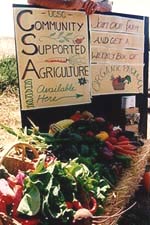|
 CSAs are local farms that have set up a Community Supported Agriculture program.
CSAs are local farms that have set up a Community Supported Agriculture program.
Hmm. That seems like a rather circular definition. Let's try again by stating how a CSA works: Consumers buy "shares" of the farmer's harvest and get a box of food each week for a specified portion of the year. The consumer gets fresh, local, in-season produce; the farmer gets up-front income to help with planting costs and to ensure a base level of income. CSAs are a win-win!
There are, of course, some ins and outs to community supported agriculture, as well as some variations on the theme, so let's plow into the subject of how CSAs work. At the end of the article we'll provide resources to help you find a CSA in your area.
Here's how CSAs generally work:
- A farmer determines how much of his or her annual output can be devoted to a CSA program.
- He or she divides that by the approximate amount of food that each share member should receive to determine how many shares they can offer.
- Prior to the start of the farming season, the farmer accepts applications (and money) for shares.
- During the picking season, each share member gets a box of fresh produce.
The amount and type of food offered in a share varies, as do share prices. A full share might cost $480 for about a 20-week season, so that's about $24 a week for a family-sized box of fruits and vegetables.
There are as many types of CSAs as there are farming operations. Here are some of the characteristics you may encounter:
- The food may be certified organic; or it may be characterized by the farmer as "pesticide-free" (grown without chemical pesticides but not certified organic); or it may be conventionally grown (with pesticides).
- Some of the food may be heirloom varieties (extra yummy!); some of the food may be hybrid or other standard varieties.
- Some CSAs offer only vegetables, but most also offer fresh fruit. Many have fresh herbs.
- Some CSAs include eggs, milk, or cheese as a part of the normal share. Others offer such products at an extra cost.
- Some may also offer homemade jams, flowers, or other niche items.
The seasonal pattern in your region will determine which crops can be grown and when they will be ready for picking; thus, the items in your box each week will vary both by region and over the course of the growing season. To make the most of your weekly bounty, you'll need to orient your meal planning to focus on what's in-season (i.e. what's in your box). There are a few CSAs that use greenhouses to supply certain high-demand items every week or to run a year-round community supported agriculture operation, but these are the exception rather than the rule.
Some CSAs will deliver your weekly box of fresh food right to your door, though that level of service usually costs extra. The norm is that you will have to drive (or bike or walk) to the pickup location to get your weekly share. Sometimes the pickups are at the farm itself, but more often they are at various locations around the community. Choosing a CSA that has a pickup location close to you is important.
Almost all CSAs offer simple "pay and pick up" type shares, but some CSAs offer an option where you spend a few hours helping with farm chores, with a commensurate lowering of the amount of money you have to pay for your share. A few CSAs require such participation. Helping out on the farm is actually a great way to get more sunshine and fresh air and to get to know the farmer and others in your community, but if kneeling in the dirt is not for you, just pick a CSA that does not require work.
Farmers and consumers both benefit from CSAs. Farmers get a stable, predictable market for their crops, and the up-front income from the share members helps spread the risks inherent in farming. The CSA approach cuts out the middlemen—brokers, truckers, grocers, and others—so farmers and consumers both benefit from the savings. Consumers also benefit by getting the freshest possible produce at a reasonable price. Freshness is one of the main factors affecting how nutritious your food is. It's also likely that you'll eat more fruits and vegetables because there will be more of them around. Are you getting your USDA-recommended nine servings of fruits and vegetables a day?
|
There is also an environmental benefit conferred by CSAs—the food doesn't have to travel very far. In the US, the average grocery store item travels 1,500-1,800 miles to reach you. With a CSA, that distance is typically reduced by a factor of 100, with the corresponding reductions in fuel use and air pollution.
|
|
PEAK OIL, YOUR FOOD, AND CSAs |
|
The modern agricultural system is extremely dependent on fossil fuels. As we head into the unknowns of a world beyond peak oil—when our current food-supply system may start to struggle under the stress of much higher fuel prices—it is not at all a bad idea to have already established a relationship with a local farmer.
|
|
Here are a few points to remember when evaluating a CSA.
Make sure the food suits your needs. It will be nearly impossible to find a CSA that will provide every single item you usually get at the grocery store, and it's not unusual to have a CSA put things in your box that you have no idea what to do with. Just
 be sure the pick a CSA whose foods match reasonably well with your culinary habits. (And, of course, don't be afraid to try a new item or two if it shows up in your box!)
be sure the pick a CSA whose foods match reasonably well with your culinary habits. (And, of course, don't be afraid to try a new item or two if it shows up in your box!)
Choose the right share size. The amount of food in a "full share" box is usually designed for a family of four. Many CSAs offer "half share" memberships that supply a lesser amount of food for a lower price.
Look for a CSA that's close-by. You don't want to have to drive 45 minutes every week to pick up your box of food (at least, not if you can help it). So pick a CSA whose drop-off locations are near where you live or work.
Make sure pick-up day and time work for you. If the pickup day/time for your preferred CSA conflict with your work schedule or some other regularly scheduled activity, call the farmer and see if alternate pickup arrangements are available. Otherwise, move on to the CSA with the next-best combination of characteristics.
Don't expect the CSA to be perfect. Remember that the goal of getting into a CSA is to replace some of what you would otherwise buy at the grocery store. It would be hard to find a CSA that meets your needs so perfectly that you can stop going to the grocery store
during the picking season. (You will, however, find that the number of trips to the market will go down, as will the bill.) Also, while the quality of the food you get in your box will usually be outstanding, remember that growing, picking, and delivering food are subject to the vagaries of weather, including temperatures, sunshine, and amount of rainfall; pests and diseases; and labor (farm hand) availability. The occasional disappointment will inevitably happen but will be ultimately dwarfed by the overall benefits of being in a CSA. Finally, expect less food in the boxes at the beginning of the season (when harvestable crops are still in short supply) and more during the middle and end of the season (when many more crops are maturing).
There are benefits to community supported agriculture that can't be captured in a simple dollars-and-cents evaluation. You'll be supporting small farmers in your community instead of mega-sized food corporations, and you'll be getting extra nutritional value from fresh-picked food that hasn't had to travel in a truck for days. It's also good to know a little about how your food is grown.
Finding a CSA is easy. Just point your web browser to one of the resources below. Many CSAs have their own web sites, too, so you can often augment the information you find in the CSA databases by doing a web search on a CSA's name.
One important thing: Don't wait until spring to sign up—all the shares will be gone! February and March are the best months to sign up. The earlier you start looking, the better chance you have of getting signed up with the CSA that best meets your needs.
So, now that you know the ABCs of CSAs, here are some resources for finding one near you (in the US):
|


